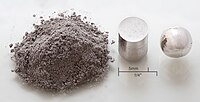
Photo from wikipedia
Summary In this paper, new in-core self-powered neutron detector emitter candidate materials, ie, vanadium, cobalt, and silver, have been examined in their lifetimes compared with the commonly used rhodium emitter.… Click to show full abstract
Summary In this paper, new in-core self-powered neutron detector emitter candidate materials, ie, vanadium, cobalt, and silver, have been examined in their lifetimes compared with the commonly used rhodium emitter. Using a new quantitative lifetime evaluation model, the lifetimes of vanadium and cobalt were determined to be longer than that of rhodium, but these materials were also shown to have the disadvantage of low signal intensities. Under normal operating conditions, we showed that rhodium emitter can be used for 2 cycles of pressurized water reactors (PWRs) with lifetime of 4.35 years, whereas silver can be used for 5 cycles of PWRs with lifetime of 8.04 years. Three sensitivity tests were performed for rhodium and silver about (1) the emitter size, (2) the fuel assembly burnup, and (3) the emitter temperature variations. From the test results, we observed that the lifetimes of rhodium and silver emitters remained 2 and 5 cycles long, respectively. We concluded that silver can significantly extend the in-core detector's lifetime in PWR operation.
Journal Title: International Journal of Energy Research
Year Published: 2017
Link to full text (if available)
Share on Social Media: Sign Up to like & get
recommendations!